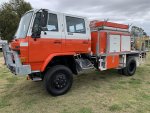Hey everyone, it's time to start compiling information on the build of our FTS700 or FTS12 (Burni) in the one place. After a few threads with specific discussions it is time to get everything in the one place. First, so I don't forget  and second, so people looking for ideas can see what does and does not work. This site has been a valuable source of info for me, so I hope this thread helps someone else looking for a project or solution to a problem.
and second, so people looking for ideas can see what does and does not work. This site has been a valuable source of info for me, so I hope this thread helps someone else looking for a project or solution to a problem.
Before I post up photos I see that I can link to external image hosts, but that means the images may not be available in the future. Is there a way to upload images directly to this site so they appear in line with the text?
Before I post up photos I see that I can link to external image hosts, but that means the images may not be available in the future. Is there a way to upload images directly to this site so they appear in line with the text?


